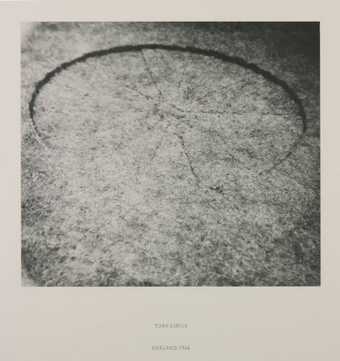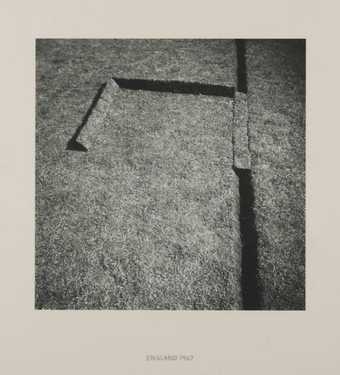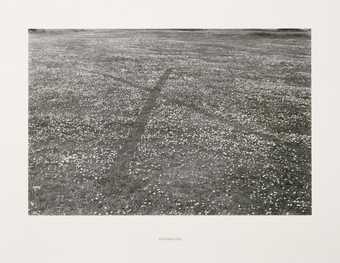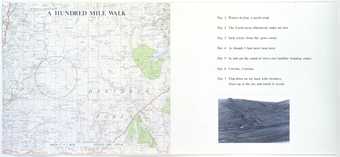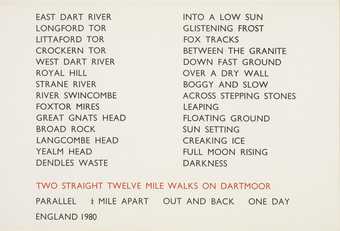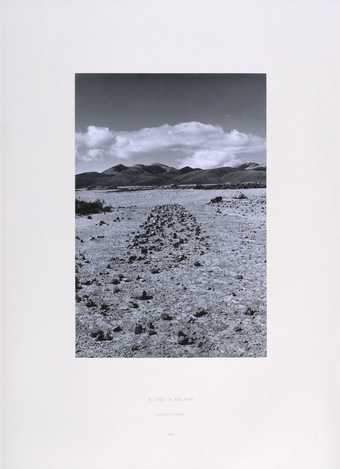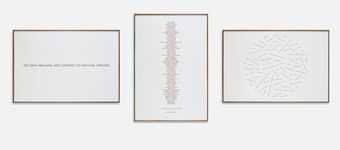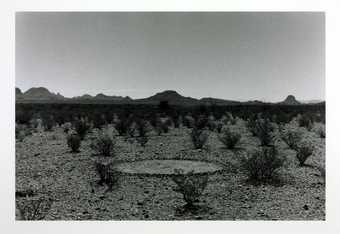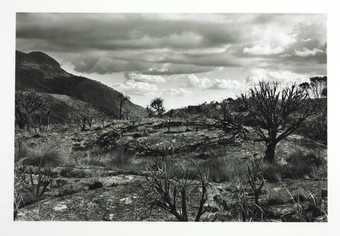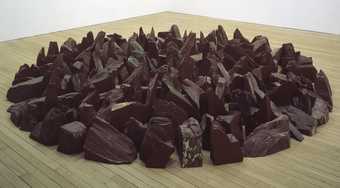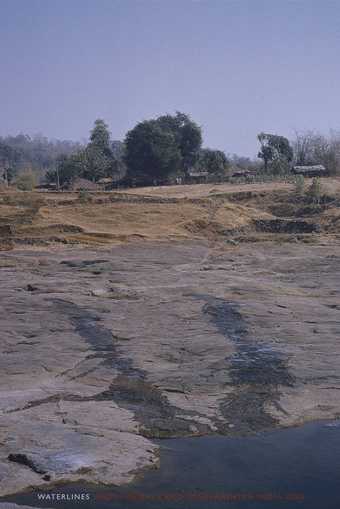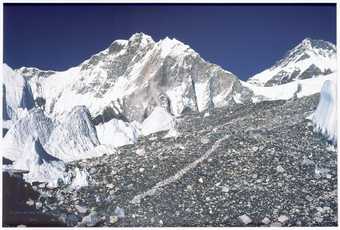
Not on display
- Artist
- Richard Long CBE born 1945
- Medium
- Digital print on paper mounted onto aluminium
- Dimensions
- Image: 159 × 1276 mm
support: 863 × 1281 × 2 mm
support, secondary: 863 × 1281 × 1 mm
frame: 872 × 1291 × 37 mm - Collection
- Tate
- Acquisition
- Presented by the artist (Building the Tate Collection) 2005
- Reference
- T12036
Summary
Since his earliest practice, begun in the late 1960s, Long has based his art on the action of walking in the natural landscape. With his seminal work, A Line Made By Walking 1967 (Tate P07149) – a photograph showing a straight line worn in a field of grass by the repeated movement of the artist’s feet over it – Long established the simple act of walking as a gesture of primordial mark-making fundamental to the creation of art. In the context of late 1960s conceptualism, Long’s act may be seen as a subversion of the traditionally expressive gesture central to painting. Walking is non-expressive, a mechanical movement which permits the body to travel from one point to another. In a similar way, the line joining one point to another is fundamental to the process of drawing – the logical means of connection on which cartography is based. In the 1970s Long extended his process of making transient marks on the landscape to include another primordial human activity: the collection and organisation of raw materials found within the environment. Over the decades he has extended the straight line to encompass the cross, the square, the circle, the spiral, concentric rings, parallel lines, crooked lines, the heap, the dribble, the scratch; every possible means of making marks in nature with what is to hand, using simple actions with the artist’s hands or feet, is covered in Long’s oeuvre. He has worked in many different kinds of terrain, walking extensively in England, particularly in the south west which is his home, and travelling to far off, spectacular wild landscapes. The pictures are often as much a record of Long’s experience of being in extreme deserted places as they are of the simple ephemeral art work being created in the environment.
The results of Long’s actions may be brought into the gallery and laid out on the floor, resulting in a sculptural work, or they are photographed in situ, resulting in a picture. Sahara Circle, like Circle in Africa 1978 (T06890), depicts a circle Long created from the elements of his surroundings on a trip to Africa. In the area of the Sahara shown in this image, the desert takes the form of reddish brown earth and rocks rather than the golden dunes more usually associated with the desert. This has permitted the artist to make a ring of rocks around a circular area he has cleared within a patch of broken stones which changes quite suddenly into finer brown sand. It is not clear in the image whether this changing texture on the earth’s surface is the result of a larger activity by the artist, or whether natural forces have caused the sudden transition. As is usual in Long’s photographs of circles in the landscape, the image is centred on the circle, above which, on the horizon, a finger of rock juts into the air dramatically. The landscape appears completely barren. Long produced several photograph and text works from his 1988 walk in the spectacular landscape of the Hoggar region of the Sahara Desert, including Hoggar Circle and Touareg Circle, in which he cleared the rocks from the earth in a circle and a ring, Sahara Line and Sahara Standing Stone Line, each showing a line of rocks made in the same rocky-textured desert, Dusty Boots Line, in which he kicked away pebbles to leave a line of dust, and Hoggar Stones: A Six Day Walk in the Sahara, all in black and white.
Sahara Circle is a unique print. Stichting Vincent Van Gogh, Amsterdam, made a poster of this print in 1990.
Further reading:
Richard Long: Walking the Line, London 2002
Richard Long: Walking in Circles, exhibition catalogue, Hayward Gallery, South Bank Centre, London 1991, reproduced p.221 in colour
Richard Long, exhibition catalogue, Palazzo delle Esponsizioni, Rome 1994, pp.4, 113,115 and 121-2
Elizabeth Manchester
October 2005
Does this text contain inaccurate information or language that you feel we should improve or change? We would like to hear from you.
Display caption
Sahara Circle was made by Long during a walk through the Hoggar region of the Sahara in southern Algeria. He arranged a ring of rocks around a circular area that he had cleared within a patch of broken stones. ‘I think circles have belonged in some way or other to all people at all times’,Long has said. ‘They are universal and timeless, like the image of a human hand. For me, that is part of their emotional power, although there is nothing symbolic or mystical in my work.’
Gallery label, April 2009
Does this text contain inaccurate information or language that you feel we should improve or change? We would like to hear from you.
Explore
- abstraction(8,615)
-
- non-representational(6,161)
-
- geometric(3,072)
- formal qualities(12,454)
-
- photographic(4,673)
- environment / nature(315)
- countries and continents(17,390)
-
- Africa(186)
- Sahara(3)
You might like
-
Richard Long CBE A Line Made by Walking
1967 -
Richard Long CBE Turf Circle
1966 -
Richard Long CBE A Line Made by Walking
1967 -
Richard Long CBE Turf Sculpture
1967 -
Richard Long CBE England 1968
1968 -
Richard Long CBE A Hundred Mile Walk
1971–2 -
Richard Long CBE Two Straight Twelve Mile Walks on Dartmoor, England 1980
1980 -
Richard Long CBE A Line in Bolivia - Kicked Stones (2 Versions)
1981 -
Richard Long CBE Ten Days Walking and Sleeping on Natural Ground
1986 -
Richard Long CBE Silence Circle Big Bend Texas
1990 -
Richard Long CBE Circle in Africa
1978 -
Richard Long CBE Red Slate Circle
1988 -
Richard Long CBE Waterlines
2003 -
Richard Long CBE A Line in the Himalayas
1975, printed 2004 -
Richard Long CBE Watershed
1992


